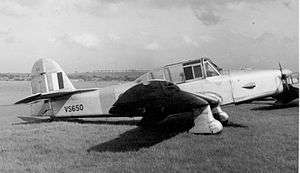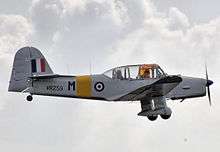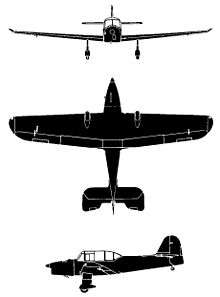Percival Prentice
| Prentice | |
|---|---|
 | |
| A Percival P.40 Prentice T.1 of No. 16 Reserve Flying School based at Derby (Burnaston) Airport in service in May 1953 | |
| Role | Military trainer aircraft |
| Manufacturer | Percival |
| First flight | 31 March 1946 |
| Introduction | November 1947 |
| Retired | 1953 |
| Primary users | Royal Air Force Argentine Air Force private pilot owners after disposal by the RAF |
| Produced | 1947-1949 |
| Number built | >370 |
|
| |
The Percival Prentice is a basic trainer of the Royal Air Force in the early postwar period. It was a low-wing monoplane with a fixed tailwheel undercarriage. Front seating was in a side-by-side configuration with a rear seat provided.
Design and development
Designed to meet Air Ministry Specification T.23/43, the Prentice was the first all-metal aircraft to be produced by the Percival Aircraft Company. The prototype Prentice TV163 first flew from Percival's factory at Luton Airport, Bedfordshire on 31 March 1946. Early trials revealed inadequate rudder control, resulting in a revised rudder and a large cutout in the elevators. The aircraft were later modified with turned-up wingtips.[1] Over 370 were delivered to the RAF between 1947 and 1949.
An unusual design feature was the provision for three seats. While the instructor and pupil were equipped with dual controls in a side-by-side arrangement in the front, a second pupil sat in the rear seat without controls to receive "air experience". Both pupils could communicate with the instructor. Night flying training was to be carried out in daylight by means of amber screens incorporated into the canopy and the use of special goggles. The amber screens were folded back when not in use.[2]
Several hundred Prentices were ordered for RAF use. Since the Percival factory was concentrating on production of the Percival Proctor and the Merganser light transport aircraft, production was sub-contracted to the Blackburn Aircraft works at Brough.[2]
Operational service
After these modifications, the Prentice was passed into RAF service, initially with the regular Flying Training Schools (FTS) including the RAF College, Cranwell where they replaced the remaining de Havilland Tiger Moths. Later deliveries went to the Reserve Flying Schools (RFS). The type was used as a pilot trainer until 1952 at the RAF College where it was replaced by the de Havilland (Canada) Chipmunk and in late 1953 at the other schools, when it was replaced by the Percival Provost. Two Air Signals Schools also operated the type to train air signallers, until the last were withdrawn from No.1 ASS at RAF Swanton Morley, Norfolk, in mid 1956.[3]
Civilian operations

252 redundant RAF Prentices were later bought in 1956 by Aviation Traders Ltd, a company owned by Freddie Laker.[4] and were stored at Stansted and Southend. Most were eventually scrapped but 28 were converted for civil use with two seats and two jumpseats behind the two pilots' seats, separated by a structure which housed the original 4-channel radio. This conversion had quite poor performance with four passengers. One aircraft (G-AOKL) was based at Stansted Aerodrome near London around 1963 and used by the Parachute Club for parachuting with at least three jumpers. One aircraft was converted to a seven-seat layout for pleasure flights. One (G-AOPL) was acquired from Shackleton Aviation at Sywell by Captain Jon Cousens, a Desert Intelligence Officer in the Trucial Oman Scouts and flown to Sharjah in 1967; later being flown on to South Africa where it remained until it ceased flying.
The aircraft had a poor performance with any load at high temperatures and initially had poor spin recovery.
Forty-two aircraft were built under licence by Hindustan Aircraft for the Indian Air Force.[5]
Variants
- Prentice T.1
- Standard three-seat trainer for Royal Air Force and export. 251 hp (187 kW) de Havilland Gipsy Queen 32 engine.[6]
- Prentice T.2
- Fitted with supercharged 296 hp (221 kW) Gipsy Queen 51.[6] One built.[5]
- Prentice T.3
- Fitted with 345 hp (257 kW) Gipsy Queen 70-2.[6] 62 built.[5]
Operators
- Argentine Air Force - Purchased 100 T.1s, with delivery from September 1948.[5]
- Royal Canadian Air Force - One aircraft was evaluated and tested by the RCAF in 1948.
- Indian Air Force - Received 20 Percival-built T.3s plus 42 built under licence by Hindustan Aircraft.[5][7]
- Lebanese Air Force - Received 3 T.1s.[5]
- Royal Air Force[8]
- Central Flying School
- No.1 FTS
- No.2 FTS
- No.3 FTS
- No.6 FTS
- No.7 FTS
- No.22 FTS
- No.16 RFS
- No.22 RFS
- No.23 RFS
- No.24 RFS
- No.25 RFS
Survivors
Airworthy survivors
- G-AOLK airworthy in 2009 with private owner at Southend Airport;
- G-APJB airworthy with Classic Air Force at Newquay Airport with air transport certificate, formerly with Air Atlantique at Coventry Airport;
- G-AOKL currently at the Shuttleworth Collection, Old Warden, who purchased it damaged, now undergoing restoration but temporarily on hold;
Aircraft On Display
- United Kingdom
- Midland Air Museum at Coventry - Prentice T.1 VS623.[9]
- Newark Air Museum - Prentice VR249, a National Benchmark airframe on the National Aviation Heritage Register.[10]
- Classic Air Force, Newquay - Used for pleasure flights but when not flying is on display in the hangar.
- United States
An ex-RAF Prentice N1041P is under restoration.
.jpg)
- Argentina
One Prentice T.1 aircraft is on display. Another one at the Escuela de Educación Técnica Aeronáutica Jorge Newbery.
- India
Another Indian Air Force Prentice IV 3381 is on static display.
- New Zealand
- National Transport & Toy Museum in Wanaka
Prentice T.Mk.1 VS316/G-AOMF/ZK-DJC is on static display.
Specifications (T.1)

Data from [11]
General characteristics
- Crew: two/three
- Length: 31 ft 3 in (9.52 m)
- Wingspan: 46 ft 0 in (14.0 m)
- Height: 12 ft 10 in (3.91 m)
- Wing area: 305 ft² (28.4 m²)
- Airfoil: R.A.F.48[12]
- Aspect ratio: 6.94:1[12]
- Empty weight: 3,232 lb (1,466 kg)
- Loaded weight: 4,200 lb (1,905 kg)
- Powerplant: 1 × de Havilland Gipsy Queen 32 6-cylinder, air-cooled inline engine, 251 hp (187 kW)
Performance
- Maximum speed: 124 knots (143 mph, 230 km/h) at 5,000 ft (1,500 m)
- Cruise speed: 118 knots (136 mph)
- Stall speed: 49 knots (56.6 mph,[12] 91 km/h) (flaps down)
- Range: 344 nm (396 mi, 637 km)
- Service ceiling: 18,000 ft (5,490 m)
- Rate of climb: 653 ft/min[12] (3.3 m/s)
See also
- Aircraft of comparable role, configuration and era
- Related lists
References
Notes
- ↑ Thetford 1976, p. 429.
- 1 2 Marsh, Jeff. "Percival "Prentice" T1". Air Atlantique Classic Flight Project, 20 September 2005. Retrieved: 14 May 2009.
- ↑ Sturtivant 1997, p. 61.
- ↑ Jackson 1974
- 1 2 3 4 5 6 Birtles Aircraft Illustrated December 1975, p. 489.
- 1 2 3 Birtles Aircraft Illustrated December 1975, p. 487.
- ↑ Birtles Aircraft Illustrated December 1975, p. 492.
- ↑ Halley 1985, pp. 76–82.
- ↑ "Aircraft Listing." Midland Air Museum. Retrieved: 22 June 2013.
- ↑ "Aircraft List." Newark Air Museum. Retrieved: 22 June 2013.
- ↑ Thetford 1976, p. 430
- 1 2 3 4 Bridgman 1951, pp. 70c–71c.
Bibliography
- Birtles, Philip J. "The Percival Prentice". Aircraft Illustrated, Vol. 8, No. 12, December 1975. pp. 487–493.
- Bridgman, Leonard. Jane's All The World's Aircraft 1951–52. LOndon: Sampson Low, Marston & Company, Ltd., 1951.
- Ellison, Norman H. Percivals Aircraft (The Archive Photographs Series). Chalford, Stroud, UK: Chalford Publishing Company, 1997. ISBN 0-7524-0774-0.
- Halley, J.J. Royal Air Force Aircraft SA100-VZ999. Tonbridge, Kent, UK: Air-Britain (Historians) Ltd. 1985. ISBN 0-85130-136-3.
- Jackson, A.J. British Civil Aircraft since 1919, Volume 3. London: Putnam, 1988. ISBN 0-85177-818-6.
- Silvester, John. "Percival Aircraft 1933-1954 (Parts 1-4)." Aeroplane Monthly, Vol. 11, No. 1–4, January–April 1983.
- Sturtivant, Ray. Royal Air Force Flying Training and Support Units. Tonbridge, Kent, UK: Air-Britain (Historians) Ltd, 1997. ISBN 0-85130-252-1.
- Thetford, Owen. Aircraft of the Royal Air Force. London: Putnam & Company Ltd., 1976. ISBN 0-370-10056-5.
External links
| Wikimedia Commons has media related to Percival Prentice. |
- "Prentice in the Air" a 1948 Flight article